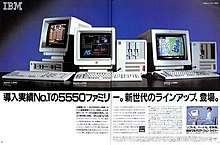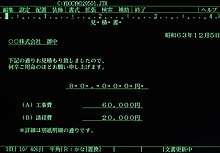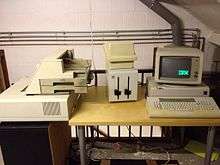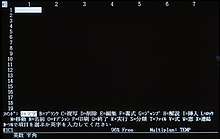IBM 5550
IBM 5550 is a personal computer series that IBM marketed in Japan, Korea, Taiwan and China in the 1980s and 1990s, for business use customers. In Japan, it was introduced in 1983 and promoted as "Multistation 5550 (マルチステーション5550)" because it had three roles in one machine: a PC, a word processing machine which was traditionally marketed as a machine different from a PC in Japan, and an IBM-host attached terminal.
| Also known as | Multistation 5550 |
|---|---|
| Developer | IBM |
| Manufacturer | Matsushita Electric Industrial |
| Type | Personal computer |
| Release date | Japan March 1983[1] |
| Introductory price | US$4,200-10000 with screen, printer, and keyboard. |
| Operating system | Japanese DOS or OS/2 |
| CPU | Intel 8086 @ 8 MHz |
| Memory | 256 kB RAM (expandable to 512 kB) |
| Display | 15-inch CRT display (24 lines × 80 characters) |
| Graphics | 1024×768 graphics monochrome or 360×512 in four colors |
| Successor | IBM Personal System/55 |

General
The IBM PC that had been marketed by IBM since 1981, using Intel 8088, was not powerful enough to process the far eastern languages of Japanese, Korean and Chinese. Nor was the resolution of IBM PC's display high enough to show the complex characters of these languages.
The IBM 5550 was first introduced in Japan in March 1983,[1] using Intel 8086 microprocessor and was called "Multistation 5550" because it had three roles in one machine: a PC, a word processing machine which was traditionally marketed in Japan as a machine different from a PC, and an online terminal.
After the Japanese 5550 models, Korean, Traditional Chinese and Simplified Chinese models were also introduced. IBM 5550 initially used its own architecture, but, later since 1987, was changed to use IBM Personal System/2's Micro Channel Architecture, being renamed as Personal System/55.
In Japan, Kiyoshi Atsumi, a film actor, was used to promote the 5550. IBM later introduced IBM JX for home users in Japan, Australia and New Zealand, and DOS/V for both business and home users in Japan.
Features

The 5550 was originally planned as a terminal with a combination of word processing and personal computing targeted for Japanese computer market.[2] To display 24 dots Mincho kanji typeface which was also used in many Japanese electrical word processors, the 5550 had high display resolution such as a 1024×768 pixel graphic screen. The 5550 read a display font from an external storage to support multilingual include Japanese, Chinese, and Korean language.[3]
The 5550 provided below three roles:
- Japanese Business Personal Computer: the Japanese DOS (日本語DOS, Nihongo DOS) developed by Microsoft.
- Japanese word processor: the Writing Program (文書プログラム, Bunsho Program) developed by IBM.
- Japanese online terminal: the 3270 Kanji Emulation (3270漢字エミュレーション) and the 5250 Kanji Emulation (5250漢字エミュレーション) developed by IBM.
The original Bunsho Program and emulators booted from a floppy disk without Nihongo DOS. They used a proprietary disk format which couldn't be read from Nihongo DOS, so users had to replace floppy disks or set the boot partition to switch between two programs. Also, they had to use a conversion program to exchange data.[4] Later, they were ported for Nihongo DOS, and functions were gradually implemented. The 3270 Kanji Emulation was superseded by the Nihongo 3270 PC released in October 1983, and the 5250 Kanji Emulation was superseded by the Nihongo 5250 PC in September 1984.[5] The Bunsho Program was also superseded by the DOS Bunsho Program in May 1986.[6]
The first generation of IBM 5550 had up to three 5¼ inch double-density (720 KB) floppy drives because the Bunsho Program used three floppy disks; program disk, font disk, and user's data disk. Later, two-drive models contained a font ROM card as other Japanese personal computers did.
Development
Yu Kawara (川原 裕) of IBM Fujisawa Development Laboratory planned the terminal with a combination of word processor and personal computer, called the Multi-functional Workstation, and he proposed it at the headquarter in March 1981.[2] The development team was founded as an Independent Business Unit (IBU).[7]

The team set goals for IBM 5550 that the machine was usable for both word processing and personal computing on the same architecture at least 3-5 years. They tried to build the 5550 from the IBM Displaywriter System 6580, the English word processor developed in Austin office in 1980, and the IBM Personal Computer developed in Boca Raton office, but it was difficult to combine different types of machines.[7]
Considering price–performance ratio and continuity of an architecture, the team examined processors chosen from Intel's and other manufacturers. The IBM PC used an Intel 8088, but the 5550 employed an Intel 8086 because bus speed largely influenced for performance of the machine which had high display resolution.[6]
To gain an advantage over competitors in Japanese word processing, 24 pixel font models render characters in a box of 26×29 pixels, and the total display resolution is 1066×725 pixels calculated with box width by 41×25 text. 16 pixel font models render characters in a box of 18×21 pixels, and the total display resolution is 738×525 pixels. The 5550 had one more column than 40 columns of usual Japanese computers, which enabled line breaking.[6]

For personal computing, the Nihongo DOS K2.00 had been developed by Microsoft. It was a Japanese localization of MS-DOS 2.0 followed to Toshiba's PASOPIA 16. The Nihongo DOS bundled the Microsoft BASIC interpreter specialized for IBM 5550. Programming languages and the Japanese version of Multiplan were also provided.[7]
The team didn't consider the machine was used for online communication, but they realized its importance during the development. They decided to add a role of a terminal in January 1982.[2] This change extended the development term.[7] In May 1982 Business Show (one of computer industry exhibitions in Japan), IBM Japan only displayed the IBM PC as a reference material. They unveiled the development of 5550 in fall 1982.[8][9]
IBM Japan didn't have a factory for mass production of personal computers, so the production of 5550 was outsourced to some companies. System units, hard disks, and monitors were manufactured by Matsushita Electric Industrial, printers by Oki Electric Industry, and keyboards by Alps Electric.[9]
Models
- 5551-A/B/C/D/E/G/H/J/K/M/P (Basic models, placed beside the display. Later became a smaller size like 5540)
- 5541-B/E/J/K/M/P (Smaller size models, on which the display can be placed. Later made even smaller)
- 5561-G/H/J/K/M/P (Larger size models, all models employ Intel 80286)
- 5530-G/H (Stand-alone models, without the communications adapter. Used 3½ inch floppy disk)
- 5535-M (Laptop, using 3½ inch floppy disk)
Competition
In Japan, Multistation 5550 competed against:
- Fujitsu FACOM 9450 and FMR Series
- NEC PC-9801 Series and NEC N5200/5300 Series
Reception
BYTE in 1983 speculated that "we may soon see a similar machine here in America". Describing the 5550 as "a true workstation", the magazine envisioned the computer as filling the "considerable gulf above the PC", and a rival to the IBM System/36 minicomputer. It praised the 5550's "unprecedented" combination of kanji support with high-end word-processing capability, and reported that in Japan an ecosystem of vendors providing products for the computer was forming. The magazine concluded that "if the American PC is any precedent, the market should soon be filled with 5550 software".[10]
See also
- IBM PC, IBM PC/AT and IBM PS/2
- IBM JX, AX architecture and DOS/V
- List of IBM products
References
- Chronology of IBM Personal Computers (1983-1986), Ken Polsson Archived March 15, 2012, at the Wayback Machine, 1983, March 15, IBM Japan announces the IBM 5550 Multistation in Japan. It features an 8 MHz Intel 8086 microprocessor, 256 kB RAM (expandable to 512 kB), up to three 640 kB capacity floppy drives, display with 1024x768 graphics monochrome or 360x512 in four colors, for US$4200-10000 with screen, printer, and keyboard. [902.144] [1314.D4
- "83年度日経製品賞最優秀賞 (3) 日本IBM・マルチステーション5550。". Nihon Keizai Shimbun. 1984-02-01. p. 20.
- "【創刊10周年記念特別企画】 Special Interview: キーマンが語る: 日本IBM情報システム(株) 竹村譲 氏、日本IBM(株) 羽鳥正彦 氏". The BASIC. 技術評論社. 120: 33–40. 1993.
- 平野, 正信 (1983-05-30). "インダストリ:出そろった多機能、複合パソコン". 日経コンピュータ. Nikkei McGraw-Hill: 49–65. ISSN 0285-4619.
- IBM Japan (1985). "最新のワークステーション IBMマルチステーション5560登場". 情報科学. 情報科学研究所. 21: 97–107. ISSN 0368-3354.
- 戸塚, 正康 (1991). 日本IBMのパソコン新戦略. 日本工業新聞社. pp. 95–111. ISBN 4819108565.
- 鈴木, 智彦 (1984-09-25). IBM 5550 活用法. オーム社. pp. 8–12.
- "16ビットパソコン戦国時代―大手の新機種勢ぞろい、日本IBMも83年春参入。". Nikkei Sangyo Shimbun. 1982-11-20. p. 1.
- "日本IBMと松下、共同開発の多機能パーソナルコン 58年3月に発売。". Nikkei Sangyo Shimbun. 1982-11-26.
- Willis, Richard (November 1983). "Big Blue Goes Japanese". BYTE. p. 164. Retrieved 19 March 2016.
External links
- (in Japanese) Introducing Multistation 5550 (describes the models in detail)